Deer
| Deer[1] Temporal range:
| |
|---|---|

| |
| Images of a few members of the family Cervidae (counterclockwise from top left): the caribou (Rangifer tarandus) and white-tailed deer (Odocoileus virginianus)
| |
| Scientific classification | |
| Domain: | Eukaryota |
| Kingdom: | Animalia |
| Phylum: | Chordata |
| Class: | Mammalia |
| Order: | Artiodactyla |
| Infraorder: | Pecora |
| Family: | Cervidae Goldfuss, 1820 |
| Type genus | |
| Cervus Linnaeus, 1758
| |
| Subfamilies | |
A deer (pl.: deer) or true deer is a hoofed ruminant ungulate of the family Cervidae. It is divided into subfamilies Cervinae (which includes, among others, muntjac, elk (wapiti), red deer, and fallow deer) and Capreolinae (which includes, among others reindeer (caribou), white-tailed deer, roe deer, and moose). Male deer of almost all species (except the water deer), as well as female reindeer, grow and shed new antlers each year. These antlers are bony extensions of the skull and are often used for combat between males.
The
Deer appear in art from Paleolithic cave paintings onwards, and they have played a role in mythology, religion, and literature throughout history, as well as in heraldry, such as red deer that appear in the coat of arms of Åland.[2] Their economic importance includes the use of their meat as venison, their skins as soft, strong buckskin, and their antlers as handles for knives. Deer hunting has been a popular activity since the Middle Ages and remains a resource for many families today.
Etymology and terminology

The word deer was originally broad in meaning, becoming more specific with time. Old English dēor and Middle English der meant a wild animal of any kind. Cognates of Old English dēor in other dead Germanic languages have the general sense of animal, such as Old High German tior, Old Norse djur or dȳr, Gothic dius, Old Saxon dier, and Old Frisian diar.[3] This general sense gave way to the modern English sense by the end of the Middle English period, around 1500. All modern Germanic languages save English and Scots retain the more general sense: for example, Dutch/Frisian dier, German Tier, and Norwegian dyr mean animal.[4]
For many types of deer in modern English usage, the male is a buck and the female a doe, but the terms vary with dialect, and according to the size of the species. The male
Distribution

Deer live in a variety of biomes, ranging from tundra to the tropical rainforest. While often associated with forests, many deer are ecotone species that live in transitional areas between forests and thickets (for cover) and prairie and savanna (open space). The majority of large deer species inhabit temperate mixed deciduous forest, mountain mixed coniferous forest, tropical seasonal/dry forest, and savanna habitats around the world. Clearing open areas within forests to some extent may actually benefit deer populations by exposing the understory and allowing the types of grasses, weeds, and herbs to grow that deer like to eat. Access to adjacent croplands may also benefit deer. Adequate forest or brush cover must still be provided for populations to grow and thrive.
Deer are widely distributed, with indigenous representatives in all continents except
The highest concentration of large deer species in temperate North America lies in the

The Eurasian Continent (including the Indian Subcontinent) boasts the most species of deer in the world, with most species being found in Asia. Europe, in comparison, has lower diversity in plant and animal species. Many national parks and protected reserves in Europe have populations of red deer, roe deer, and fallow deer. These species have long been associated with the continent of Europe, but also inhabit Asia Minor, the Caucasus Mountains, and Northwestern Iran. "European" fallow deer historically lived over much of Europe during the Ice Ages, but afterwards became restricted primarily to the Anatolian Peninsula, in present-day Turkey.
Present-day fallow deer populations in Europe are a result of historic man-made introductions of this species, first to the Mediterranean regions of Europe, then eventually to the rest of Europe. They were initially park animals that later escaped and reestablished themselves in the wild. Historically, Europe's deer species shared their deciduous forest habitat with other herbivores, such as the extinct

The highest concentration of large deer species in temperate Asia occurs in the mixed deciduous forests, mountain coniferous forests, and taiga bordering North Korea, Manchuria (Northeastern China), and the Ussuri Region (Russia). These are among some of the richest deciduous and coniferous forests in the world where one can find Siberian roe deer, sika deer, elk, and moose. Asian caribou occupy the northern fringes of this region along the Sino-Russian border.
Deer such as the sika deer,
The highest concentration of large deer species in the tropics occurs in Southern Asia in India's Indo-Gangetic Plain Region and

The Chao Praya River Valley of Thailand was once primarily tropical seasonal moist deciduous forest and wet savanna that hosted populations of hog deer, the now-extinct
). One way that different herbivores can survive together in a given area is for each species to have different food preferences, although there may be some overlap.As a result of acclimatisation society releases in the 19th century, Australia has six introduced species of deer that have established sustainable wild populations. They are fallow deer, red deer, sambar, hog deer, rusa, and chital. Red deer were introduced into New Zealand in 1851 from English and Scottish stock. Many have been domesticated in deer farms since the late 1960s and are common farm animals there now. Seven other species of deer were introduced into New Zealand but none are as widespread as red deer.[7]
Description

Deer constitute the second most diverse family of artiodactyla after bovids.[8] Though of a similar build, deer are strongly distinguished from antelopes by their antlers, which are temporary and regularly regrown unlike the permanent horns of bovids.[9] Characteristics typical of deer include long, powerful legs, a diminutive tail and long ears.[10] Deer exhibit a broad variation in physical proportions. The largest extant deer is the moose, which is nearly 2.6 metres (8 ft 6 in) tall and weighs up to 800 kilograms (1,800 lb).[11][12] The elk stands 1.4–2 metres (4 ft 7 in – 6 ft 7 in) at the shoulder and weighs 240–450 kilograms (530–990 lb).[13] The northern pudu is the smallest deer in the world; it reaches merely 32–35 centimetres (12+1⁄2–14 in) at the shoulder and weighs 3.3–6 kilograms (7+1⁄4–13+1⁄4 lb). The southern pudu is only slightly taller and heavier.[14] Sexual dimorphism is quite pronounced – in most species males tend to be larger than females,[15] and, except for the reindeer, only males have antlers.[16]
Coat colour generally varies between red and brown,
Deer are also excellent jumpers and swimmers. Deer are ruminants, or cud-chewers, and have a four-chambered stomach. Some deer, such as those on the island of Rùm,[27] do consume meat when it is available.[28]
Nearly all deer have a facial gland in front of each eye. The gland contains a strongly scented
Antlers
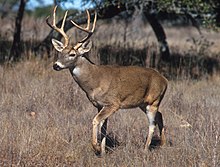
All male deer have antlers, with the exception of the water deer, in which males have long tusk-like canines that reach below the lower jaw.[29] Females generally lack antlers, though female reindeer bear antlers smaller and less branched than those of the males.[30] Occasionally females in other species may develop antlers, especially in telemetacarpal deer such as European roe deer, red deer, white-tailed deer and mule deer and less often in plesiometacarpal deer. A study of antlered female white-tailed deer noted that antlers tend to be small and malformed, and are shed frequently around the time of parturition.[31]

The fallow deer and the various subspecies of the reindeer have the largest as well as the heaviest antlers, both in absolute terms as well as in proportion to body mass (an average of eight grams per kilogram of body mass);

Antlers might be one of the most exaggerated male
In elk in Yellowstone National Park, antlers also provide protection against predation by wolves.[39]
Homology of tines, that is, the branching structure of antlers among species, have been discussed before the 1900s.[40][41][42] Recently, a new method to describe the branching structure of antlers and determining homology of tines was developed.[43]
Teeth

Most deer bear 32 teeth; the corresponding
Biology

Diet
Deer are
Reproduction
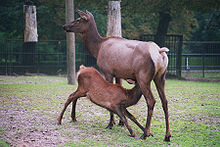
Nearly all cervids are so-called
Disease
In some areas of the UK, deer (especially
Docile moose may suffer from
Deer, elk and moose in North America may suffer from chronic wasting disease, which was identified at a Colorado laboratory in the 1960s and is believed to be a prion disease. Out of an abundance of caution hunters are advised to avoid contact with specified risk material (SRM) such as the brain, spinal column or lymph nodes. Deboning the meat when butchering and sanitizing the knives and other tools used to butcher are amongst other government recommendations.[56]
Evolution
Deer are believed to have evolved from antlerless,
Eocene
The
Oligocene

The formation of the
Miocene
Fossil evidence suggests that the earliest members of the superfamily Cervoidea appeared in Eurasia in the Miocene. Dicrocerus, Euprox and Heteroprox were probably the first antlered cervids.[66] Dicrocerus featured single-forked antlers that were shed regularly.[67] Stephanocemas had more developed and diffuse ("crowned") antlers.[68] Procervulus (Palaeomerycidae) also had antlers that were not shed.[69] Contemporary forms such as the merycodontines eventually gave rise to the modern pronghorn.[70]
The Cervinae emerged as the first group of extant cervids around 7–9 Mya, during the late Miocene in central Asia. The tribe Muntiacini made its appearance as † Muntiacus leilaoensis around 7–8 Mya;[71] The early muntjacs varied in size–as small as hares or as large as fallow deer. They had tusks for fighting and antlers for defence.[14] Capreolinae followed soon after; Alceini appeared 6.4–8.4 Mya.[72] Around this period, the Tethys Ocean disappeared to give way to vast stretches of grassland; these provided the deer with abundant protein-rich vegetation that led to the development of ornamental antlers and allowed populations to flourish and colonise areas.[14][62] As antlers had become pronounced, the canines were either lost or became poorly represented (as in elk), probably because diet was no longer browse-dominated and antlers were better display organs. In muntjac and tufted deer, the antlers as well as the canines are small. The tragulids have long canines to this day.[59]
Pliocene
With the onset of the
Around 5 Mya, the rangiferina
Pleistocene
Large deer with impressive antlers evolved during the early Pleistocene, probably as a result of abundant resources to drive evolution.[14] The early Pleistocene cervid † Eucladoceros was comparable in size to the modern elk.[78] † Megaloceros (Pliocene–Pleistocene) featured the Irish elk (M. giganteus), one of the largest known cervids. The Irish elk reached 2 metres (6+1⁄2 ft) at the shoulder and had heavy antlers that spanned 3.6 metres (11 ft 10 in) from tip to tip.[79] These large animals were traditionally thought to have faced extinction due to conflict between sexual selection for large antlers and body and natural selection for a smaller form,[80] but a combination of anthropogenic and climatic pressures is now thought to be the most likely culprit.[81] Meanwhile, the moose and reindeer radiated into North America from Siberia.[82]
Taxonomy and classification
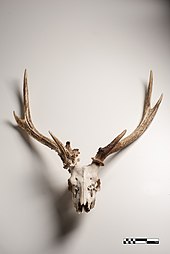
Deer constitute the
Other attempts at the classification of deer have been based on morphological and
In 1987, the zoologists Colin Groves and Peter Grubb identified three subfamilies: Cervinae, Hydropotinae and Odocoileinae; they noted that the hydropotines lack antlers, and the other two subfamilies differ in their skeletal morphology.[85] They reverted from this classification in 2000.[86]
Molecular phylogenetic analyses since the latter half of the 2000s all show that
External relationships
Until 2003, it was understood that the family
Internal relationships
A 2006
| Cervidae |
| |||||||||||||||||||||||||||||||||||||||||||||||||||||||||
Human interaction
Prehistoric
Deer were an important source of food for early hominids. In China,
Historic
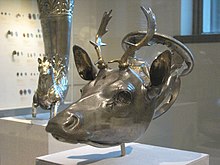
Deer had a central role in the ancient art, culture and mythology of the
The common male first name
Literary

Deer have been an integral part of fables and other literary works since the inception of writing. Stags were used as symbols in the latter Sumerian writings. For instance, the boat of Sumerian god Enki is named the Stag of Azbu. There are several mentions of the animal in the
In one of
Heraldic


Deer of various types appear frequently in European heraldry. In the British armory, the term "stag" is typically used to refer to antlered male red deer, while "buck" indicates an antlered male fallow deer. Stags and bucks appear in a number of attitudes, referred to as "lodged" when the deer is lying down, "trippant" when it has one leg raised, "courant" when it is running, "springing" when in the act of leaping, "statant" when it is standing with all hooves on the ground and looking ahead, and "at gaze" when otherwise statant but looking at the viewer. Stags' heads are also frequently used; these are typically portrayed without an attached neck and as facing the viewer, in which case they are termed "caboshed".[103]
Examples of deer in
Other types of deer used in heraldry include the hind, portrayed much like the stag or buck but without antlers, as well as the reindeer and winged stags. Winged stags are used as supporters in the arms of the de Carteret family. The sea-stag, having the antlers, head, forelegs and upper body of a stag and the tail of a mermaid, is often found in German heraldry.[103]
Economic
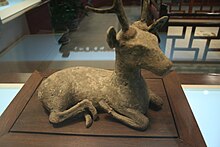
Deer have long had economic significance to humans. Deer meat, known as venison, is highly nutritious.[123][124] Due to the inherently wild nature and diet of deer, venison is most often obtained through deer hunting. In the United States, it is produced in small amounts compared to beef, but still represents a significant trade. Deer hunting is a popular activity in the U.S. that can provide the hunter's family with high quality meat and generates revenue for states and the federal government from the sales of licenses, permits and tags. The 2006 survey by the U.S. Fish and Wildlife Service estimates that license sales generate approximately $700 million annually. This revenue generally goes to support conservation efforts in the states where the licenses are purchased. Overall, the U.S. Fish and Wildlife Service estimates that big game hunting for deer and elk generates approximately $11.8 billion annually in hunting-related travel, equipment and related expenditures.[125] Conservation laws prevent the sale of unlicensed wild game meat, although it may be donated.
Deer have often been bred in captivity as ornaments for parks, but only in the case of reindeer has thorough domestication succeeded.
Automobile collisions with deer can impose a significant cost on the economy. In the U.S., about 1.5 million deer-vehicle collisions occur each year, according to the National Highway Traffic Safety Administration. Those accidents cause about 150 human deaths and $1.1 billion in property damage annually.[129] In Scotland, several roads including the A82, the A87 and the A835 have had significant enough problems with deer vehicle collisions (DVCs) that sets of vehicle activated automatic warning signs have been installed along these roads.[130]

The skins make a peculiarly strong, soft leather, known as
Since the early 20th century, deer have become commonly thought of as pests in New Zealand due to a lack of predators on the island causing population numbers to increase and begin encroaching on more populated areas. They compete with livestock for resources, as well as cause excess erosion and wreak havoc on wild plant species and agriculture alike. They can also have an effect on the conservation efforts of other plant and animal species, as they can critically offset the balance within an environment by drastically depleting diversity within forests.[133]
See also
- Australian Deer Association
- Deer forest
- Deer management
- Largest cervids
- Reindeer hunting in Greenland
References
- ^ 'deer' singular and plural among examples (swine OE swin, deer OE deor, sheep OE sceap, horse OE hors, year OE gear, pound OE pana) -Jespersen, A Modern English Grammar on Historical Principles, Part II SYNTAX (First Volume), Ch.III The Unchanged Plural (p. 49) arrow.latrobe.edu.au accessed 14 November 2020
- ISBN 951-593-915-1
- ^ "deer". The American Heritage Dictionary of the English Language (4th ed.). Houghton Mifflin Company. 2000. Archived from the original on 25 March 2004.
- ^ Harper, Douglas. "Deer". Online Etymology Dictionary. Retrieved 7 June 2012.
- OED, s.v. hart and hind
- ^ "Havier". Dictionary.com. Retrieved 4 August 2012.
- ^ McLintock, A. H., ed. (1966). "Deer". Te Ara: An Encyclopaedia of New Zealand.
- ^ ISBN 978-0-801-88735-2.
- ISBN 978-1-4729-2531-2.
- ISBN 978-0-520-23582-3.
- ISBN 9789546423139.
- ISBN 978-0-8018-7135-1.
- ^ ISBN 978-0-472-06497-7.
- ^ ISBN 978-0-8117-0496-0.
- ISBN 978-1-60732-048-7.
- ISBN 978-1-4081-8996-2.
- ^ ISBN 978-1-4214-0387-8.
- ISBN 978-1-84537-735-9.
- ^ Trolle, M.; Emmons, L. H. (2004). "A record of a dwarf brocket from Lowland Madre De Dios, Peru" (PDF). Deer Specialist Group News (19): 2–5.
- ISBN 978-1-4773-0886-8.
- ISBN 978-0-7748-0728-9.
- ISBN 978-1-4729-1153-7.
- ISBN 978-0-618-15313-8.
- ISBN 978-1-4402-2702-8.
- .
- (PDF) from the original on 9 October 2022.
- ^ Owen, James (25 August 2003). "Scottish Deer Are Culprits in Bird Killings". National Geographic News. Archived from the original on 29 August 2003. Retrieved 16 June 2009.
- ^ Dale, Michael (1988). "Carnivorous Deer". Omni Magazine: 31.
- ISBN 978-0-7614-7270-4.
- ^ ISBN 978-0-08-045415-3.
- JSTOR 1375571.
- ISBN 978-0-7524-9592-7.
- ISBN 978-0-9510826-0-7.
- PMID 15695205.
- .
- JSTOR 3671833.
- S2CID 10418779.
- PMID 15695205.
- S2CID 52147419.
- ^ Garrod, A. Notes on the visceral anatomy and osteology of the ruminants, with a suggestion regarding a method of expressing the relations of species by means of formulae. Proceedings of the Zoological Society of London, 2–18 (1877).
- ^ Brooke, V. On the classification of the Cervidæ, with a synopsis of the existing Species. Journal of Zoology 46, 883–928 (1878).
- ^ Pocock, R. The Homologies between the Branches of the Antlers of the Cervidae based on the Theory of Dichotomous Growth. Journal of Zoology 103, 377–406 (1933).
- ^ Samejima, Y., Matsuoka, H. A new viewpoint on antlers reveals the evolutionary history of deer (Cervidae, Mammalia). Sci Rep 10, 8910 (2020). https://doi.org/10.1038/s41598-020-64555-7
- ISBN 978-0-395-93596-5.
- ISBN 978-0-87196-871-5.
- ^ Uresk, Daniel W., and Donald R. Dietz. "Fecal vs. Rumen Contents to Determine White-tailed Deer Diets." Intermountain Journal of Sciences 24, no. 3-4 (2018): 118–122.
- JSTOR 1381075.
- S2CID 84790827.
- ^ Deer – info and games Sheppard Software.
- PMID 16434219.
- S2CID 7102058.
- S2CID 2429198.
- PMID 12359464.
- PMID 21414734.
- ^ a b Alan Cochrane (January 2019). "Don't fraternize with wild animals: biologist". Moncton Times&Transcript.
- ^ "Wildlife and Heritage Service : Chronic Wasting Disease (CWD)". Maryland Department of Natural Resources. Archived from the original on 14 May 2013.
- ^ ISBN 9780323140430.
- ^ ISBN 978-0-521-35519-3.
- ^ ISBN 978-1-58544-515-8.
- S2CID 13157519.
- ISBN 978-1-4613-8271-3.
- ^ PMID 15120401.
- (PDF) from the original on 23 April 2016.
- .
- ISBN 978-0-912627-04-5.
- .
- .
- .
- ^ Ginsburg, L. (1988). "La faune des mammifères des sables Miocènes du synclinal d'Esvres (Val de Loire)" [The mammalian fauna of the Miocene sands of the syncline Esvres (Loire Valley)]. Comptes Rendus de l'Académie des Sciences. II (in French): 319–22.
- (PDF) from the original on 9 October 2022.
- .
- ^ PMID 16584894.
- ^ Di Stefano, G.; Petronio, C. (2002). "Systematics and evolution of the Eurasian Plio-Pleistocene tribe Cervini (Artiodactyla, Mammalia)" (PDF). Geologica Romana. 36: 311–34. Archived from the original (PDF) on 10 March 2016. Retrieved 11 April 2016.
- .
- ^ Ghaffar, A.; Akhtar, M.; Nayyer, A. Q. (2011). "Evidences of Early Pliocene fossil remains of tribe Cervini (Mammalia, Artiodactyla, Cervidae) from the Siwaliks of Pakistan" (PDF). Journal of Animal and Plant Sciences. 21 (4): 830–5. Archived (PDF) from the original on 9 October 2022.
- .
- ISBN 978-0-300-08142-8.
- ^ De Vos, J.; Mol, D.; Reumer, J. W. F. (1995). "Early Pleistocene Cervidae (Mammalia, Artiodactyla) from the Oosterschelde (the Netherlands), with a revision of the cervid genus Eucladoceros Falconer, 1868" (PDF). Deinsea (2): 95–121. Archived (PDF) from the original on 9 October 2022.
- S2CID 4417046.
- ^ Moen, R. A.; Pastor, J.; Yosef, C. (1999). "Antler growth and extinction of Irish elk" (PDF). Evolutionary Ecology Research (1): 235–49. Archived (PDF) from the original on 29 October 2013.
- ISSN 1040-6182.
- (PDF) from the original on 9 October 2022.
- OCLC 62265494.
- .
- ISBN 978-0-87474-981-6.
- (PDF) from the original on 9 October 2022.
- PMID 15522810.
- PMID 16584894.
- ^ Hassanin, A., Delsuc, F., Ropiquet, A., Hammer, C., van Vuuren, B. J., Matthee, C., Ruiz-Garcia, M., Catzeflis, F., Areskoug, V., Nguyen, T. T., & Couloux, A. (2012). Pattern and timing of diversification of Cetartiodactyla (Mammalia, Laurasiatheria), as revealed by a comprehensive analysis of mitochondrial genomes. Comptes Rendus Biologies, 335(1), 32–50.
- ^ Heckeberg, N. S., Erpenbeck, D., Wörheide, G., & Rössner, G. E. (2016). Systematic relationships of five newly sequenced cervid species. PeerJ, 4, e2307.
- ^ Heckeberg, N. S. (2020). The systematics of the Cervidae: A total evidence approach. PeerJ, 8, e8114.
- ^ PMID 12746147.
- ^ ISBN 9781421403885.
- ISBN 978-1400043484.
- S2CID 90662935.
- S2CID 261164022.
- ISBN 978-1-4116-9960-1.
- ^ Harding, Andrew (23 September 2006). "Beijing's penis emporium". BBC News. Retrieved 23 June 2010.
- ISBN 0500018022.
- ISBN 978-0826451019.
- ^ Moore, Clement C. (2 December 1823). "An Account of A Visit from St. Nicholas". Troy Sentinel. p. 2. Retrieved 27 March 2015.
- ISBN 978-0142408735.
- ^ Arthur Fox-Davies, A Complete Guide to Heraldry, T.C. and E.C. Jack, London, 1909, 208–210,
- ^ Courthope, William (1839). Debrett's Complete Peerage of the United Kingdom of Great Britain and Ireland: With Additions to the Present Time and a New Set of Coats of Arms from Drawings by Harvey. J. G. & F. Rivington.
- ^ "ГЕРБ ГОРОДА БАЛАХНА". ГЕРБОВНИК.РУ. Retrieved 5 November 2023.
- ^ "Символика". АДМИНИСТРАЦИЯ МУНИЦИПАЛЬНОГО ОБРАЗОВАНИЯ "ГУСЕВСКИЙ ГОРОДСКОЙ ОКРУГ". Retrieved 5 November 2023.
- ^ "Положение о символах города Нижнего Новгорода". Городская Дума Нижнего Новгорода. 20 December 2006. Retrieved 5 November 2023.
- ^ "ГЕРБ ОДИНЦОВСКОГО ГОРОДСКОГО ОКРУГА". ГЕРБОВНИК.РУ. Retrieved 5 November 2023.
- ^ "ГЕРБ СЛАВСКОГО МУНИЦИПАЛЬНОГО ОКРУГА". ГЕРБОВНИК.РУ. Retrieved 5 November 2023.
- ^ "ГЕРБ ЯМАЛО-НЕНЕЦКОГО АВТОНОМНОГО ОКРУГА". ГЕРБОВНИК.РУ. Retrieved 5 November 2023.
- ^ "CoA of Åland". EUROPEANA HERALDICA. National Archives of Finland. Retrieved 5 November 2023.
- ^ "Velkommen til Gjemnes kommune". Gjemnes kommune. Retrieved 5 November 2023.
- ^ "Hitra kommune". Hitra kommune. Retrieved 6 November 2023.
- ^ "Hjartdal kommune". Hjartdal kommune. Retrieved 6 November 2023.
- ^ "Rendalen kommune". Rendalen kommune. Retrieved 6 November 2023.
- ^ "Jelenia Gora - Deer Mountain Coat of Arms". Patchion. Retrieved 6 November 2023.
- ISBN 91-7886-092-X, p.150
- ^ "Coat of Arms". Queensland Government. 5 July 2017. Retrieved 6 November 2023.
- ^ "Paeria de Cervera". Paeria de Cervera. Retrieved 6 November 2023.
- ^ "Andris Teikmanis: jaunizveidotais ģerbonis atveido Sēlijas unikalitāti, identitāti un vēsturi". Latvijas Valsts Prezidents. 31 May 2022. Retrieved 6 November 2023.
- ^ "Latviešu vēsturisko zemju ģerboņu likums". Likumi. 18 October 2023. Retrieved 6 November 2023.
- ^ "Emblemas nacionales". Ministerio de Relaciones Exteriores. Gobierno de Chile. Retrieved 6 November 2023.
- ^ Kralj, Richard Andrew (September 2014). "Venison, Is It For You?". Penn State Extension. Retrieved 20 January 2020.
- ^ Blythman, Joanna; Sykes, Rosie (September 2013). "Why venison is good for you | Joanna Blythman and Rosie Sykes". The Guardian. Retrieved 20 January 2020.
- ^ "U.S. Department of the Interior, Fish and Wildlife Service, and U.S. Department of Commerce, U.S. Census Bureau. 2006 National Survey of Fishing, Hunting, and Wildlife-Associated Recreation" (PDF). Archived (PDF) from the original on 9 October 2022. Retrieved 16 November 2012.
- ^ a b Rines, George Edwin, ed. (1920). . Encyclopedia Americana.
- Medium (service). Retrieved 28 August 2014.
- ^ Burden, Dan (June 2012). "Deer Venison Ranching Profile". Agricultural Marketing Resource Center. Archived from the original on 20 April 2016. Retrieved 11 April 2016.
- ^ "Worst states for auto-deer crashes". CNN.com. 14 November 2006. Retrieved 5 April 2009.
- ^ "North West Area: Vehicle Activated Deer Warning Signs" (PDF). Transport Scotland. April 2010. 07/NW/0805/046. Archived from the original (PDF) on 16 March 2014. Retrieved 11 July 2013.
{{cite journal}}: Cite journal requires|journal=(help) - ^ "Inuit Bering Sea Eskimo Walrus Ivory and Iron Semi-Lunar Knife 'Ulu' (1800 to 1900 Inuit)". Archived from the original on 2 October 2018. Retrieved 2 October 2018.
- ^ Kawtikwar, Pravin (2010). "Deer antlers- Traditional use and future perspectives". Indian Journal of Traditional Knowledge. 9: 245–251.
- ISSN 0301-4223.
Further reading
- Deerland: America's Hunt for Ecological Balance and the Essence of Wildness by Al Cambronne, Lyons Press (2013), ISBN 978-0-7627-8027-3
External links
- Family Cervidae at the Animal Diversity Web
- Chronic Wasting Disease Information
- Lydekker, Richard (1911). . Encyclopædia Britannica. Vol. 7 (11th ed.). pp. 922–924.
- World of Deer Museum Archived 22 October 2020 at the Wayback Machine
- Encyclopedia of Oklahoma History and Culture – Deer
- . . 1914.











